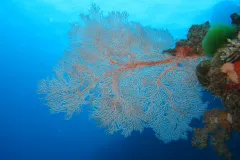The Great Barrier Reef – Going, Going, Gone???

Australia’s Great Barrier Reef (or the GBR as it is known to reef aficionados) stretches for more than 2,300 kilometers (over 1,429 miles) and can be seen from outer space. This largest barrier reef in the world is both a national icon and a global treasure that was recognized as a World Heritage site over thirty years ago.
Yet a recent study published in the Proceedings of the National Academy of Sciences suggests that large portions of the GBR have been on a trajectory of decline for much of this period. Between 1986 and 2012, over half of the living coral has been lost. If current trends continue, over 90 percent or more of the living coral will be gone from the central and southern parts of the reef in just 10 years.
How could such a tragedy be unfolding, given that the GBR has been a marine park since 1975 and more than one-third has gone completely unfished since 2004? As with most cases of reef decline, there is no single explanation. About 42 percent of the losses have been due to predation by the crown-of-thorns seastar, 48 percent due to damage from typhoons, and the remainder due to coral bleaching caused by unusually warm water.
Importantly, the northern parts of the reef, which are less influenced by the activities of people, is holding its own. These patterns suggest a way forward to halt, and reverse, the decline.
In the short-term, reducing the magnitude and frequency of outbreaks by crown-of-thorns seastars (Acanthaster planci) is the most practical step. Protecting the fish that eat the seastars by reducing fishing pressure has already helped: the frequency of outbreaks in unprotected areas is seven-times that in protected areas. But outbreaks are also more likely to occur when flooding takes place, probably because floods bring nutrients to the reef and feed the developing larvae of the seastars. Although the storms that bring flooding can’t be controlled, better agricultural practices could help enormously. Models suggest that before European agriculture was established, outbreaks occurred only once every 50-80 years, compared to the once every 15 years today.
In the long-term, however, reducing carbon dioxide emissions will be necessary to save the GBR. Without such steps, bleaching events will become more and more common, and the negative effects of ocean acidification will increasingly kick in. Australian efforts can buy invaluable time, but the entire world needs to act if we want the Great Barrier Reef to survive for our children and grandchildren.
Editor's Note: Dr. Knowlton was on PBS NewsHour to discuss the Great Barrier Reef's coral dieoff. Watch the video of the interview!


